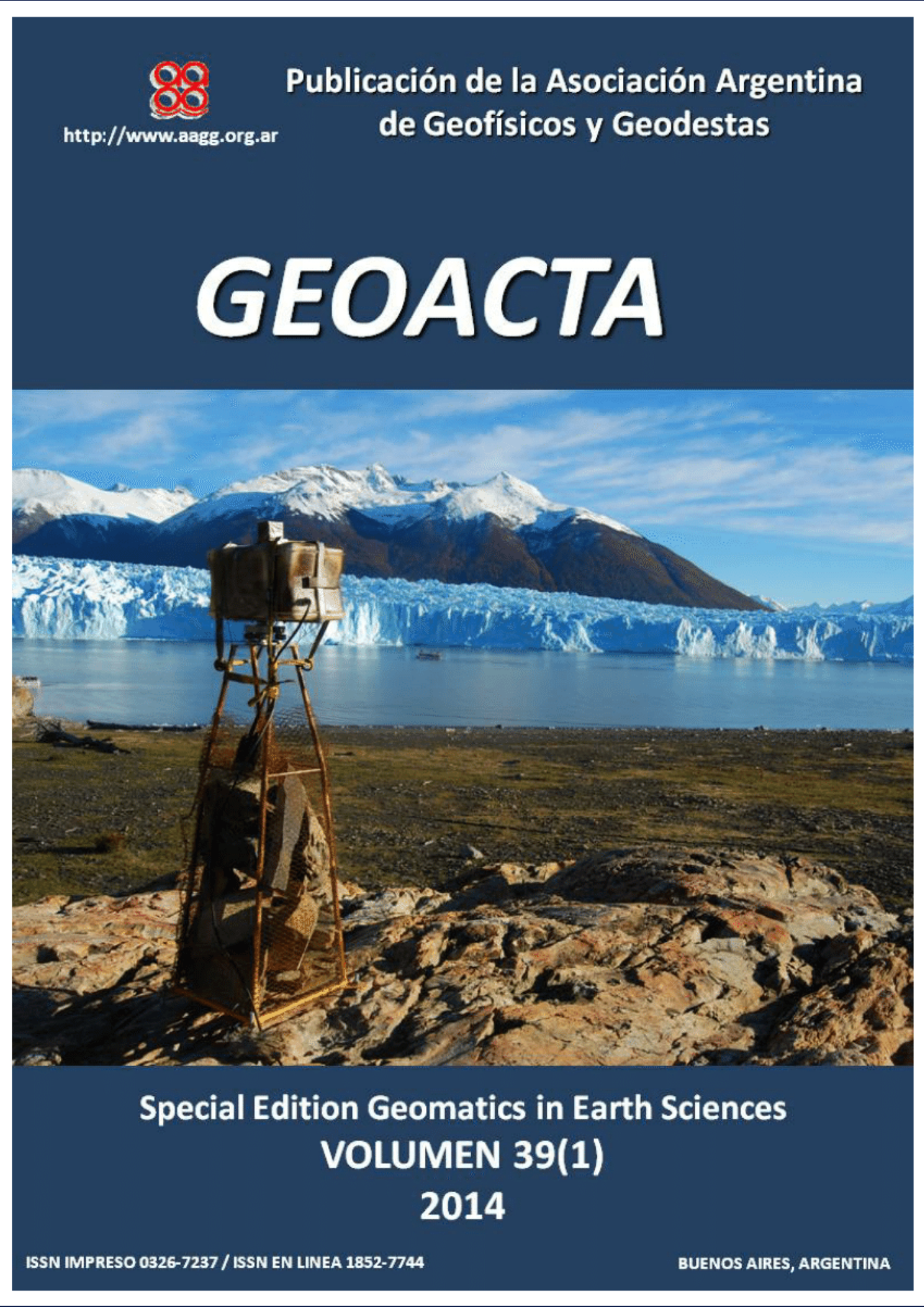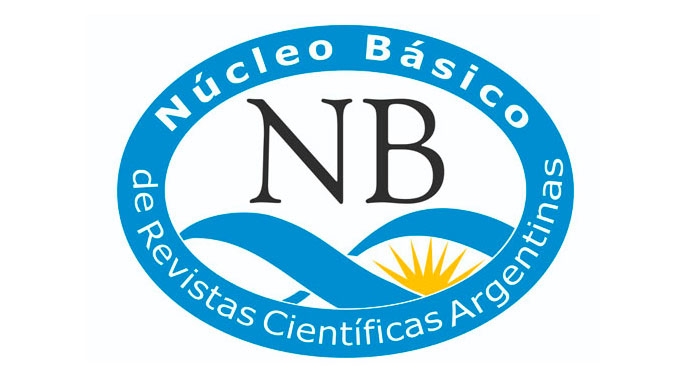Using geotechnologies for mapping water storage changes in the pampeana region from grace data
Keywords:
time-variable gravity from GRACE mission, equivalent water height, Salado River basin, La Picasa LagoonAbstract
The Earth’s gravity field does not remain constant but changes over time depending on several factors such as redistribution of the masses due to hydrological cycles. The GRACE (Gravity Recovery and Climate Experiment) satellite mission provides time-variable readings of variations in the Earth’s gravity field at a spatial resolution of ~400 km. Because of the direct relationship between mass and gravity, it is possible to obtain the related changes in water storage from the Equivalent Water Height (EWH). The aim of this work is to analyze the regional changes in water storage from a representation of the spatio-temporal EWH variations obtained from GRACE solutions for the period 2003-2010 in the Salado river basin, located in the Pampeana Region of Argentina. The GMT (Generic Mapping Tools) open-source software was used for this representation, as it allows for simplification and automation of the mapping process using scripts to create maps all within a single application. Afterwards, GRACE results were validated by comparison with GPCP (Global Precipitation Climatology Project) rainfall data as well as GLDAS (Global Land Data Assimilation System) soil moisture and hydrometric heights of the Picasa Lagoon in the Salado River basin. This mission detected significant EWH variations in the period under study, which could be associated with maximum and minimum precipitations that occurred in the region. The EWH and hydrometric height signals both showed a similar behavior and a negative trend within the period 2002-2009. The correlation between both signals was greater than 75%, showing a good adjustment between different geophysical variables.
Downloads
References
Bruinsma, S., Lemoine, J.M., Biancale, R., Valès N., (2010). CNES/GRGS 10-day gravity field models (release 2) and their evaluation. Advances in Space Research, 45 (4): 587-601. doi: https://doi.org/10.1016/j.asr.2009.10.012
Carballo, S., Rebella, C., Hartmann, T., (2000). Evolución de los procesos de anegamiento en el área de la laguna "La Picasa" para el periodo 1970-2000. Instituto de Clima y Agua - INTA, Enero 2000.
Chambers, D.P., (2006). Evaluation of new GRACE time-variable gravity data over the ocean. Geophysical Research Letters, 33, L17603. doi: https://doi.org/10.1029/2006GL027296
Chen, J.L., Wilson C.R., Famiglietti J.S., Rodell M., (2005). Spatial sensitivity of GRACE time-variable gravity observations. Journal of Geophysical Research, 110, B08408. doi: https://doi.org/10.1029/2004JB003536
Costa, S.M.A., Matos, A.C.O.C., Blitzkow, D., (2011). Validation of the land water storage from gravity recovery and climate experiment (GRACE) with gauge data in the amazon basin. Boletim de Ciências Geodésicas, 18 (2): 262-281. doi: https://doi.org/10.1590/S1982-21702012000200006
Latrubesse, E., y Brea, D., (2009). Floods in Argentina. Developments in Earth Surface Processes, 13 (1900): 333-349. doi: https://doi.org/10.1016/S0928-2025(08)10016-5
Matos, A.C.O.C., Blitzkow, D., Almeida, F.G.V., Costa, S.M.A., Campos, I.O., Barbosa, A.C., (2012). Analysis of water level variations in Brazilian basins using GRACE. Journal of Geodetic Science, 2: 76 - 87. doi: https://doi.org/10.2478/v10156-011-0034-7
Morishita, Y., y Heki, K., (2008). Characteristic precipitation patterns of El Niño/La Niña in time-variable gravity fields by GRACE. Earth and Planetary Science Letters, 272 (3-4): 677-682. Elsevier B.V. doi: https://doi.org/10.1016/j.epsl.2008.06.003
Pacino, M.C., Pereira, A., Cotlier, C., (2011). Utilización de datos gravimétricos GRACE e imágenes NOAA en un análisis multitemporal de la masa hídrica de la cuenca del río Paraná (Argentina). Revista Geoacta de la Asociación Argentina de Geofísicos y Geodestas, 36: 211-228. ISSN 1852-7744.
Pereira, A., Miranda, S., Pacino, M.C., Forsberg, R., (2012a). Water storage changes from GRACE data in the La Plata Basin. IAG Series: Geodesy for Planet Earth, 136 (3): 613-618. ISBN 978-3-642-20338-1, ISSN 0939-9585, Springer-Verlag Berlin Heidelberg Ed.
Pereira, A., Pacino, M.C., (2012b). Annual and seasonal water storage changes detected from GRACE data in the La Plata Basin. Physics of the Earth and Planetary Interiors, 212-213: 88-99. ISSN 0031-9201, Ed. Elsevier.
Ramillien, G., Frappart F., Cazenave A, Güntner A., (2007). Time variations of land water storage from an inversion of 2 years of GRACE geoids. Earth and Planetary Science Letters, 235, 283-301.
Rosenstein, S., Montico, S., Bonel, B., Rosenstein, C., (2009). El caso de las inundaciones en la laguna La Picasa: ¿Una oportunidad para la construcción de una representación colectiva del “desastre ambiental”?. Revista de investigaciones de la Facultad de Ciencias Agrarias. N°VX. http://www.fcagr.unr.edu.ar/Investigacion/revista/rev15/1.htm Servicio Meteorológico Nacional (SMN), 2012. Servicios climáticos. Disponible en <http://www.smn.gov.ar/serviciosclimaticos/?mod=hidro&id=5> (último acceso Noviembre 2012).
Subsecretaría de Recursos Hídricos de la Nación (SRHN) e Instituto Nacional del Agua (INA) (2002). Atlas digital de los Recursos Hídricos Superficiales de la República Argentina [Digital Atlas of the Hydrologic Surface Resources of Argentina]. SRHN and INA, Buenos Aires, Argentina, disponible en CD-Rom.
Tapley, B.D., Bettadpur, S., Ries, J.C., Thompson, P.F., Watkins, M.M., (2004). GRACE measurements of mass variability in the Earth system. Science (New York, N.Y.), 305 (5683): 503-5. doi: https://www.science.org/doi/10.1126/science.1099192
Tapley B., Bettadpur S., Watkins M., Reigber C., (2004b). The gravity recovery and climate experiment: mission overview and early results. Geophysical Research Letters, 31: L09607. doi: https://doi.org/10.1029/2004GL019920
Wahr, J., Swenson S., Zlotnicki V., Velicogna I., (2004). Time-variable gravity from GRACE: First results. Geophysical Research Letter, 31: L11501. doi: https://doi.org/10.1029/2004GL019779
Wessel, P. y Smith W.H.F., (1991). Free software helps map and display data, EOS Trans. AGU, 72, 441p.
Wessel, P. y Smith W.H.F., (1998). New, improved version of the Generic Mapping Tools released, EOS Trans. AGU, 79,579p.
Xavier, L., Becker, M., Cazenave, A., Longuevergne, L., Llovel, W., Filho, O.C.R., (2010). Interannual variability in water storage over 2003–2008 in the Amazon Basin from GRACE space gravimetry, in situ river level and precipitation data. Remote Sensing of Environment, 114 (8): 1629-1637. Elsevier Inc. doi: https://doi.org/10.1016/j.rse.2010.02.005
Downloads
Published
How to Cite
Issue
Section
License
Copyright (c) 2014 Ayelén Pereira, Cecilia Cornero, Ma. Cristina Pacino, Ana C. Oliveira Cancoro de Matos

This work is licensed under a Creative Commons Attribution-NonCommercial-ShareAlike 4.0 International License.
Starting in 2022 (Vol. 43 number 2) articles will be published in the journal under a Creative Commons Attribution-NonCommercial-ShareAlike 4.0 International license (CC BY-NC-SA 4.0)
According to these terms, the material can be shared (copied and redistributed in any medium or format) and adapted (remixed, transformed and created from the material another work), provided that a) the authorship and the original source of its publication (journal and URL of the work), b) is not used for commercial purposes and c) the same license terms are maintained.
Prior to this date the articles were published in the journal under a Creative Commons Attribution license (CC BY)
In both cases, the acceptance of the originals by the journal implies the non-exclusive assignment of the economic rights of the authors in favor of the editor, who allows reuse, after editing (postprint), under the license that corresponds according to the edition.
Such assignment means, on the one hand, that after its publication (postprint) in the GEOACTA Magazine of the Association of Geophysicists and Geodesists, the authors can publish their work in any language, medium and format (in such cases, it is requested that it be recorded that the material was originally published in this journal); on the other, the authorization of the authors for the work to be harvested by SEDICI, the institutional repository of the National University of La Plata, and to be disseminated in the databases that the editorial team considers appropriate to increase visibility. of the publication and its authors.
Likewise, the journal encourages the authors so that after their publication in the Journal of the Association of Geophysicists and Geodesists, they deposit their productions in other institutional and thematic repositories, under the principle that offering society scientific production and Unrestricted academic scholarship contributes to a greater exchange of global knowledge.
















